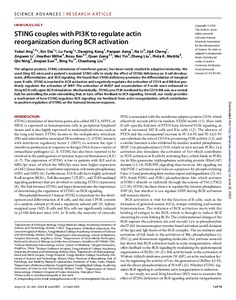| dc.contributor.author | Jiang PP | |
| dc.contributor.author | Miller H | |
| dc.contributor.author | Yang L | |
| dc.contributor.author | Mattila PK | |
| dc.contributor.author | Ning Q | |
| dc.contributor.author | Liu Z | |
| dc.contributor.author | Kang DQ | |
| dc.contributor.author | Cheng JL | |
| dc.contributor.author | Yin W | |
| dc.contributor.author | Li N | |
| dc.contributor.author | Yu B | |
| dc.contributor.author | Sun JQ | |
| dc.contributor.author | Ren BX | |
| dc.contributor.author | Liu CH | |
| dc.contributor.author | Dai X | |
| dc.contributor.author | Jing YK | |
| dc.contributor.author | Gong Q | |
| dc.contributor.author | Li JW | |
| dc.date.accessioned | 2022-10-28T13:54:00Z | |
| dc.date.available | 2022-10-28T13:54:00Z | |
| dc.identifier.uri | https://www.utupub.fi/handle/10024/168145 | |
| dc.description.abstract | The adaptor protein, STING (stimulator of interferon genes), has been rarely studied in adaptive immunity. We used Sting KO mice and a patient's mutated STING cells to study the effect of STING deficiency on B cell development, differentiation, and BCR signaling. We found that STING deficiency promotes the differentiation of marginal zone B cells. STING is involved in BCR activation and negatively regulates the activation of CD1 9 and Btk but positively regulates the activation of SHIP. The activation of WASP and accumulation of F-actin were enhanced in Sting KO B cells upon BCR stimulation. Mechanistically, STING uses PI3K mediated by the CD19-Btk axis as a central hub for controlling the actin remodeling that, in turn, offers feedback to BCR signaling. Overall, our study provides a mechanism of how STING regulates BCR signaling via feedback from actin reorganization, which contributes to positive regulation of STING on the humoral immune response. | |
| dc.language.iso | en | |
| dc.publisher | AMER ASSOC ADVANCEMENT SCIENCE | |
| dc.title | STING couples with PI3K to regulate actin reorganization during BCR activation | |
| dc.identifier.urn | URN:NBN:fi-fe2021042824161 | |
| dc.relation.volume | 6 | |
| dc.contributor.organization | fi=biolääketieteen laitos, yhteiset|en=Institute of Biomedicine| | |
| dc.contributor.organization | fi=MediCity|en=MediCity Research Laboratory| | |
| dc.contributor.organization-code | 2607100 | |
| dc.converis.publication-id | 47734182 | |
| dc.converis.url | https://research.utu.fi/converis/portal/Publication/47734182 | |
| dc.identifier.eissn | 2375-2548 | |
| dc.identifier.jour-issn | 2375-2548 | |
| dc.okm.affiliatedauthor | Mattila, Pieta | |
| dc.okm.affiliatedauthor | Dataimport, MediCity | |
| dc.okm.discipline | 3111 Biomedicine | en_GB |
| dc.okm.discipline | 3111 Biolääketieteet | fi_FI |
| dc.okm.internationalcopublication | international co-publication | |
| dc.okm.internationality | International publication | |
| dc.okm.type | Journal article | |
| dc.publisher.country | United States | en_GB |
| dc.publisher.country | Yhdysvallat (USA) | fi_FI |
| dc.publisher.country-code | US | |
| dc.relation.articlenumber | ARTN eaax9455 | |
| dc.relation.doi | 10.1126/sciadv.aax9455 | |
| dc.relation.ispartofjournal | Science Advances | |
| dc.relation.issue | 17 | |
| dc.year.issued | 2020 | |
